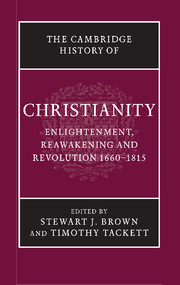Book contents
- Frontmatter
- Introduction
- PART I CHURCH, STATE, AND SOCIETY IN THE EUROPEAN WORLD, 1660–1780
- 1 Continental Catholic Europe
- 2 Continental Protestant Europe
- 3 Great Britain and Ireland
- 4 The church in economy and society
- PART II CHRISTIAN LIFE IN THE EUROPEAN WORLD, 1660–1780
- PART III MOVEMENTS AND CHALLENGES
- PART IV CHRISTIAN DEVELOPMENTS IN THE NON-EUROPEAN WORLD
- PART V REVOLUTION AND THE CHRISTIAN WORLD
- Chronology
- Bibliography
- Index
- References
3 - Great Britain and Ireland
from PART I - CHURCH, STATE, AND SOCIETY IN THE EUROPEAN WORLD, 1660–1780
Published online by Cambridge University Press: 28 March 2008
- Frontmatter
- Introduction
- PART I CHURCH, STATE, AND SOCIETY IN THE EUROPEAN WORLD, 1660–1780
- 1 Continental Catholic Europe
- 2 Continental Protestant Europe
- 3 Great Britain and Ireland
- 4 The church in economy and society
- PART II CHRISTIAN LIFE IN THE EUROPEAN WORLD, 1660–1780
- PART III MOVEMENTS AND CHALLENGES
- PART IV CHRISTIAN DEVELOPMENTS IN THE NON-EUROPEAN WORLD
- PART V REVOLUTION AND THE CHRISTIAN WORLD
- Chronology
- Bibliography
- Index
- References
Summary
The state church ideal
The civil wars fought within the British Isles from the Scottish ‘Bishops’ Wars’ of 1638–39 into the 1650s were essentially wars of religion, often initiated as bids for control of national churches. Almost all parties to these conflicts had initially held the rightness of a homogeneous, authoritative church congruent with the polity; what distinguished the participants were their goals for that united body. Yet the realities of conflict splintered this ideal: in the 1640s the ‘plural society’ triumphed as each man did what was right in his own eyes. This teeming, passionate sectarianism meant that at the Restoration of the monarchy in 1660 a revived state church was the least likely of political possibilities. Yet the ideal of a national church was first reinstituted, and then enjoyed a hegemonic position into the 1820s.
This was especially so in England. The idea of an ‘Ecclesia Anglicana‘ had a millennium of varied development behind it by 1660; the Thirty-Nine Articles of 1563 had drawn upon older assumptions in referring without explication to ‘Every particular or National Church’ (Article 34). The sense in which the church in England was regarded as the Church of England was strengthened but not invented in the 1530s and 1550s. The mutually supporting relation between the secular and the sacred was a high ideal as well as a set of administrative procedures, and a legitimate role for the Christian prince in governing the church was conventionally traced back to Constantine. In 1660, each of the component territories of a restored composite monarchy sought to apply a still-powerful ideal.
- Type
- Chapter
- Information
- The Cambridge History of Christianity , pp. 54 - 71Publisher: Cambridge University PressPrint publication year: 2006

